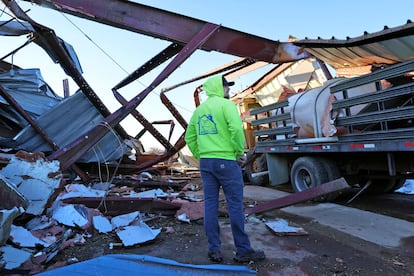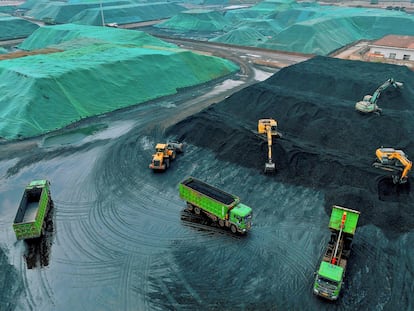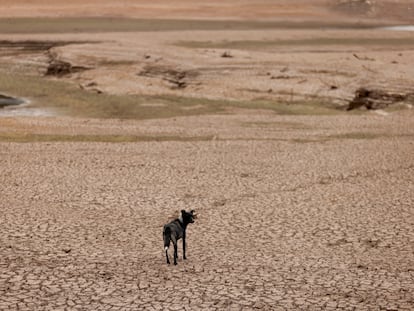Summer-like conditions with record temperatures lead to first Wisconsin tornado in February
Winter tornadoes are likely to be stronger and stay on the ground longer with a wider swath of destruction in a warming world, a 2021 study showed

The first tornado ever recorded in Wisconsin in the usually frigid month of February came on a day that broke records for warmth, setting up the perfect scenario for the type of severe weather normally seen in the late spring and summer.
At least one tornado was confirmed south of Madison and the National Weather Service was investigating reports of several more spawned from storms that swept across the southeastern part of the state around 5:30 p.m. on Thursday, said meteorologist Taylor Patterson.
“There wasn’t anything inherently unusual about any of these storms when you compare them to other types of severe events we see during the summer and spring,” Patterson said Friday. “It’s just unusual in the sense that it doesn’t normally happen in February.”
Hunter Oller, 20, of Brodhead, Wisconsin, and his friend were out fishing when the storm rolled in. They started to drive home but pulled over in the Town of Magnolia where they spotted two partially formed tornadoes and one tornado that seemed to touch the ground. Oller pulled out his cellphone.
“I was in awe,” he said. Oller called it an experience “I won’t get the joy of seeing or experiencing for awhile.” Winter tornadoes are almost unheard of, especially in northern states. The National Oceanic and Atmospheric Administration reported that between 1998 and 2022, 31 states across a broad swatch of the country, from Washington state in the northwest to New Mexico in the south, Wisconsin in the Upper Midwest over to Maine in the northeast, didn’t report a single tornado.
But winter tornadoes — like the one in Wisconsin — are likely to be stronger and stay on the ground longer with a wider swath of destruction in a warming world, a 2021 study showed. That comes after a 2018 study found that tornadoes were moving farther east, into states like Wisconsin.
Tornadoes are most common in Wisconsin over the summer months between May and August. Since 1948, between November and February fewer than a dozen tornadoes total had been reported before Thursday, according to the weather service.
Meteorologists in Wisconsin began to worry about conditions coming together to create severe weather earlier in the week and then on Thursday “we knew that there things were starting to align much more than we had thought two days ago,” Patterson said.
“All the ingredients coming together this time of year is what is unusual,” she said. The weather service dispatched teams across the path of the storm on Friday to determine how many tornadoes there were and at what severity. Photos and video taken near Evansville, Wisconsin, that were posted on social media sites clearly showed a tornado with lightning flashing around it.
“February is normally a month where we’re very cold and we’re getting snow, which are things that aren’t very conducive to tornadoes,” Patterson said. “Normally, for thunderstorms severe enough to create tornadoes, we need a lot of moisture, we need a lot of warm temperatures and during the winter months we’re just normally not in an environment that is conducive for that.”
Conditions collided in Wisconsin late afternoon on Thursday creating the perfect conditions for tornadoes to form, Patterson said. That included rapidly warming temperatures that topped out at a record-tying 55 degrees Fahrenheit (13 Celsius) in Madison and more moisture with rapidly rising air, creating thunderstorms, Patterson said.
“The other thing that we had going for us is it was really windy yesterday,” she said, creating wind shear that is important for creating tornadoes. “That basically helps us sustain that rotation that is needed for tornadoes.”
There were no reports of significant injuries. Local emergency management officials reported dozens of buildings, power lines and other structures that were damaged across the path of the storm that began to form in eastern Iowa and died out around Milwaukee, which set a record high of 59 degrees (15 Celsius).
A study released last year found that America will probably get more killer tornado- and hail-spawning supercells as the world warms. The study in the Bulletin of the American Meteorological Society predicted a nationwide 6.6% increase in supercells and a 25.8% jump in the area and time the strongest supercells will be over land.
Sign up for our weekly newsletter to get more English-language news coverage from EL PAÍS USA Edition
Tu suscripción se está usando en otro dispositivo
¿Quieres añadir otro usuario a tu suscripción?
Si continúas leyendo en este dispositivo, no se podrá leer en el otro.
FlechaTu suscripción se está usando en otro dispositivo y solo puedes acceder a EL PAÍS desde un dispositivo a la vez.
Si quieres compartir tu cuenta, cambia tu suscripción a la modalidad Premium, así podrás añadir otro usuario. Cada uno accederá con su propia cuenta de email, lo que os permitirá personalizar vuestra experiencia en EL PAÍS.
¿Tienes una suscripción de empresa? Accede aquí para contratar más cuentas.
En el caso de no saber quién está usando tu cuenta, te recomendamos cambiar tu contraseña aquí.
Si decides continuar compartiendo tu cuenta, este mensaje se mostrará en tu dispositivo y en el de la otra persona que está usando tu cuenta de forma indefinida, afectando a tu experiencia de lectura. Puedes consultar aquí los términos y condiciones de la suscripción digital.
More information
Archived In
Últimas noticias
The metaverse, four years later: Is it finished or just at a standstill?
$3,000 and a plane ticket: The United States increases incentives for migrants to self-deport before the end of the year
Charles Dubouloz, mountaineering star, retires at 36 with a farewell tour inspired by Walter Bonatti
From the White House to diplomatic gifts: Lego wins over adult fans, brick by brick
Most viewed
- The low-cost creative revolution: How technology is making art accessible to everyone
- Christian Louboutin: ‘Young people don’t want to be like their parents. And if their parents wear sneakers, they’re going to look for something else’
- All the effects of gentrification in one corner of Mexico’s Colonia Roma
- Christmas loses its festive spirit: ICE fears cast shadow over religious celebrations
- Liset Menéndez de la Prida, neuroscientist: ‘It’s not normal to constantly seek pleasure; it’s important to be bored, to be calm’










































